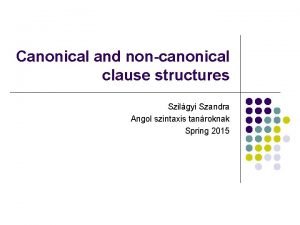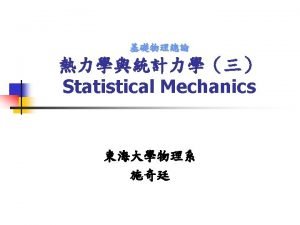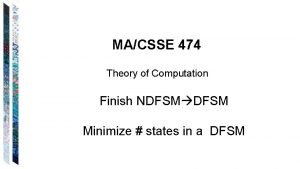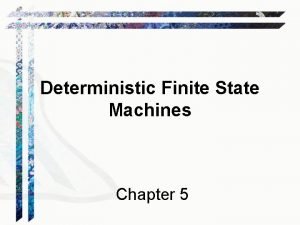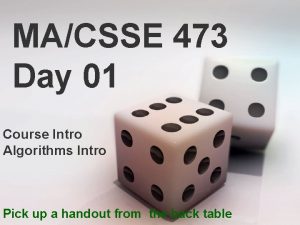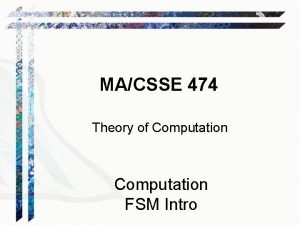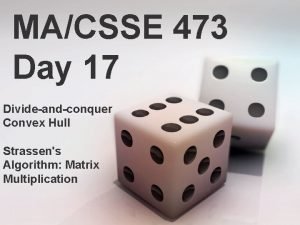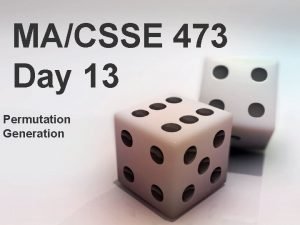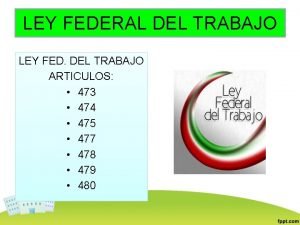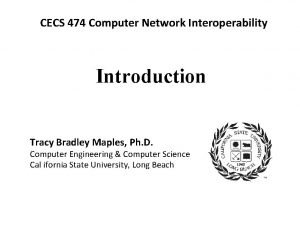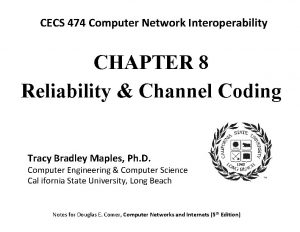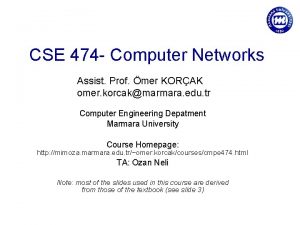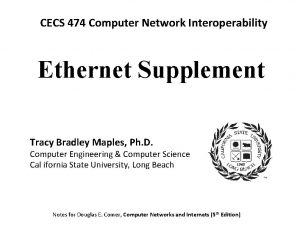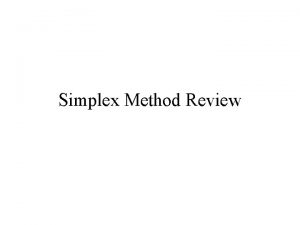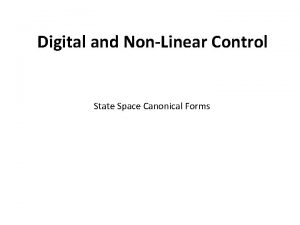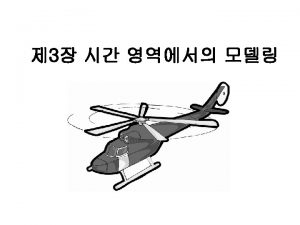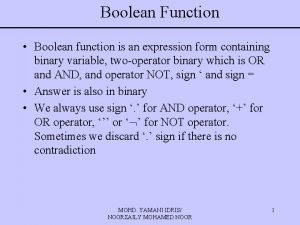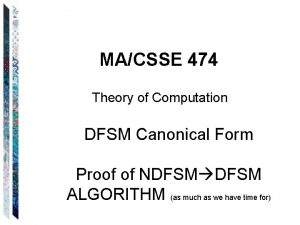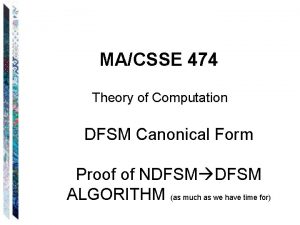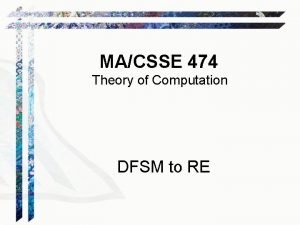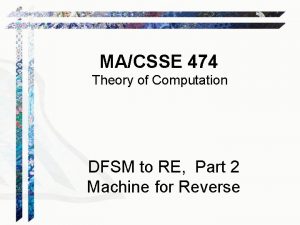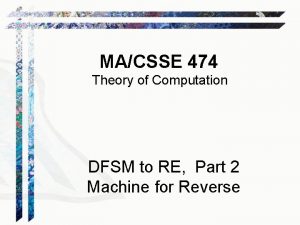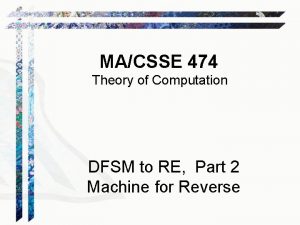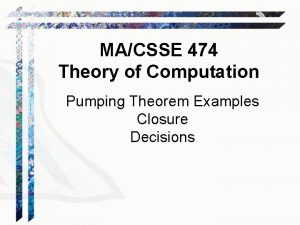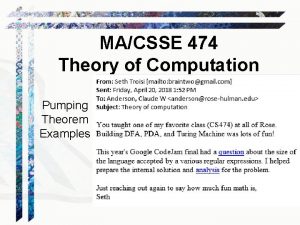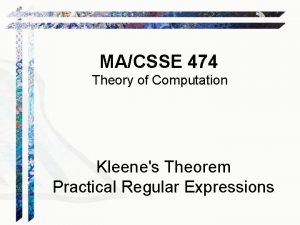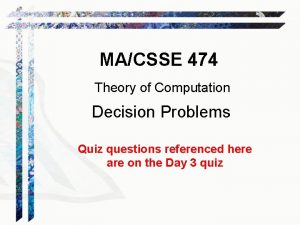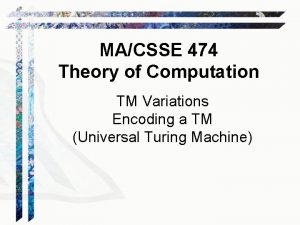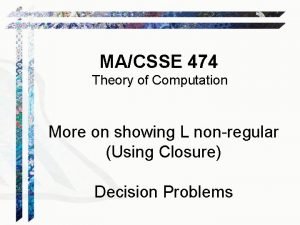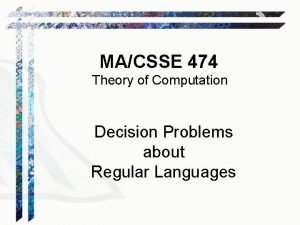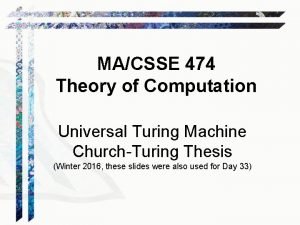MACSSE 474 Theory of Computation DFSM Canonical Form




















- Slides: 20

MA/CSSE 474 Theory of Computation DFSM Canonical Form Proof of NDFSM ALGORITHM (as much as we have time for) This version includes the "answers"

Your Questions? • Previous class days' material • Reading Assignments • HW 5 problems • Tuesday's Exam • Anything else

Canonical Forms A canonical form for some set of objects C assigns exactly one representative to each class of “equivalent” objects in C. Further, each such representative is distinct, so two objects in C share the same representation iff they are “equivalent” in the sense for which we define the form. In order for a canonical form to be useful, there must be a procedure which, given an object from the set, computes its canonical form.

A Canonical Form for FSMs build. FSMcanonicalform(M: FSM) = 1. M = ndfsmtodfsm(M). 2. M* = min. DFSM(M ). 3. Create a unique assignment of names to the states of M*. The simple algorithm 4. Return M*. for unique name Given two FSMs M 1 and M 2: build. FSMcanonicalform(M 1) = build. FSMcanonicalform(M 2) iff L(M 1) = L(M 2). assignment is in the textbook; we will illustrate it here by doing an example.

NDFSMto. DFSM Correctness

The Algorithm ndfsmtodfsm(M: NDFSM) = 1. For each state q in KM do: 1. 1 Compute eps(q). 2. s' = eps(s) 3. Compute ': 3. 1 active-states = {s'}. 3. 2 ' = . 3. 3 While there exists some element Q of active-states for which ' has not yet been computed do: For each character c in M do: new-state = . For each state q in Q do: For each state p such that (q, c, p) do: new-state = new-state eps(p). Add the transition (q, c, new-state) to '. If new-state active-states then insert it. 4. K' = active-states. 5. A' = {Q K' : Q A }.

Correctness Proof of ndfsmtodfsm To prove: From any NDFSM M = (K, , , s, A), ndfsmtodfsm constructs a DFSM M'= (K', , ', s', A'), which is equivalent to M. K' P(K) (a. k. a. 2 K) s' = eps(s) A' = {Q K : Q A } '(Q, a) = {eps(p): p K and (q, a, p) for some q Q}

Correctness Proof of ndfsmtodfsm From any NDFSM M, ndfsmtodfsm constructs a DFSM M', which is: (1) M' is Deterministic: By the definition in step 3 of ', we are guaranteed that ' is defined for all reachable elements of K' and all possible input characters. Further, step 3 inserts a single value into ' for each state-input pair, so M' is deterministic. (2) M' is Equivalent to M: We constructed ' so that M' mimics an “all paths” simulation of M. We must now prove that simulation returns the same result that M would.

A Useful Lemma: Let w be any string in *, let p and q be any states in K, and let P be any state in K'. Then: (q, w) |-M* (p, ) iff ((eps(q), w) |-M' * (P, ) and p P). INFORMAL RESTATEMENT OF LEMMA: In other words, if the original NDFSM M starts in state q and, after reading the string w, can land in state p ( along at least one of its paths), then the new DFSM M' must behave as follows: When started in the state of M' that corresponds to the set of states the original machine M could get to from q without consuming any input, M' reads the string w and lands in a state P (P is some set of M's states) that contains p. Furthermore, the if part implies: If p is any state of M that is part of the state P K' that M' (starting from q and reading w) must end up then M could get to p from q after reading w and then following any available epsilon-transitions.

A Useful Lemma: Let w be any string in *, let p and q be any states in K, and let P be any state in K'. Then: . (q, w) |-M* (p, ) iff ((eps(q), w) |-M' * (P, ) and p P) Recall: NDFSM M = (K, , , s, A), DFSM M'= (K', , ', s', A'), It turns out that we will only need this lemma for the case where q = s, but the more general form is easier to prove by induction. This is common in induction proofs. Proof: We must show that ' has been defined so that the individual steps of M', when taken together, do the right thing for an input string w of any length. Since the definitions describe one step at a time, we will prove the lemma by induction on |w|.

Base Case: |w| = 0, so w = • if part: Prove: (eps(q), ) |-M' * (P, ) p P (q, ) |-M*(p, ) Since w = and M' (being deterministic) contains no transitions, M' makes no moves. So M' must end in the same state it started in, namely eps(q). So P = eps(q). Now, since P contains p, then p eps(q). But, given the definition of eps, this means that, in the original NDFSM M, p is reachable from q just by following -transitions. So (q, ) |-M*(p, ).

Base Case • only if part: We need to show: (q, ) |-M* (p, ) (eps(q), ) |-M'* (P, ) and p P If w = and the original machine M goes from q to p with only as input, it must go from q to p following just -transitions. So p eps(q). M' starts in eps(q). Since M' contains no -transitions, it will make no moves at all if its input is . So it will halt in exactly the same state it started in, namely eps(q). So P = eps(q) and thus contains p. So M' halts in a state that includes p.

Induction Step Let w have length k + 1. Then w = zc where z * has length k, and c . Induction assumption. The lemma is true for z. So we show that, assuming that M and M' behave identically for the first k characters, they behave identically for the last character also and thus for the entire string of length k + 1. Recap: The Definition of '(Q, a) = {eps(p) : q Q ((q, a, p) )}

What We Need to Prove The relationship between: • The computation of the NDFSM M: (q, w) |-M* (p, ) and • The computation of the DFSM M': (eps(q), w) |-M'* (P, ) and p P In the next slide we replace w by zc.

What We Need to Prove Rewriting w as zc: • The computation of the NDFSM M: (q, zc) |-M* (p, ) and • The computation of the DFSM M': (eps(q), zc) |-M'* (P, ) and p P In the next slide we break up the actions of both machines on zc into actions on z followed by action(s) on c.

What We Need to Prove Breaking w into two pieces: • The computation of the NDFSM M: (q, zc) |-M* (si, c) |-M* (p, ) and • The computation of the DFSM M': (eps(q), zc) |-M'* (Q, c) |-M' (P, ) and p P In other words, after processing z, M will be in one of some set of states S, whose elements we write as si. M' will be in some "set state" that we call Q. Again, well split the proof into two parts: In the M derivation above, the second |-M has a * due to the possibility of epsilon moves. In the M' derivation there is no * because of no epsilon moves in a deterministic machine.

If Part We must prove: (eps(q), zc) |-M'* (Q, c) |-M' (P, ) and p P (q, zc) |-M* (si, c) |-M* (p, ) If, after reading z, M' is in state Q, we know from the induction hypothesis that the original machine M, after reading z, must be in some state from a set of states S and that Q is precisely that set. If M', starting in Q and reading x, lands in P, then from the definition of ', P contains precisely the states that M could land in after starting in any state in S and reading c. Thus if p P, p must be a state that M could land in if started in si on reading c.

Only If Part We must prove: (q, zc) |-M* (si, c) |-M* (p, ) (eps(q), zc) |-M'* (Q, c) |-M' (P, ) and p P By the induction hypothesis, if M, after processing z, can reach some set of states S, then Q (the state M' is in after processing z) must contain precisely all the states in S. So from Q, reading c, M' must be in some set state P that contains precisely the states that M can reach starting in any of the states in S, reading c, and then following all transitions. Thus after consuming zc, M', when started in eps(q), must end up in a state P that contains all and only the states p that M, when started in q with input zc, could end up in.

Back to the Theorem If w L(M) then: • The original machine M, when started in its start state, can consume w and end up in an accepting state. • (eps(s), w) |-M'* (Q, ) for some Q containing some state r A. – – In the statement of the lemma, let q equal s and p = r for some r A. Then M', when started in its start state, eps(s), will consume w and end in a state that contains r. But if M' does that, then it has ended up in one of its accepting states (by the definition of A' in step 5 of the algorithm). So M' accepts w (by the definition of what it means for a machine to accept a string).

Back to the Theorem If w L(M) (i. e. the original NDFSM does not accept w): • The original machine M, when started in its start state, will not be able to end up in an accepting state after reading w. • If (eps(s), w) |-M'* (Q, ), then Q contains no state r A. This follows directly from the lemma. The two cases, taken together, show that M' accepts exactly the same strings that M accepts.
 Canonical and non canonical clauses
Canonical and non canonical clauses Ensemble n
Ensemble n Ndfsm to dfsm
Ndfsm to dfsm Define dfsm
Define dfsm Standard lp form
Standard lp form Macsse
Macsse Macsse
Macsse Macsse
Macsse Macsse
Macsse Ley fed del trabajo
Ley fed del trabajo Cecs 474
Cecs 474 Topology in computer network
Topology in computer network Cse 474
Cse 474 Cecs 474
Cecs 474 Art 474 lft
Art 474 lft Canonical form linear programming
Canonical form linear programming Find the transfer function of the following block diagram
Find the transfer function of the following block diagram Canonical observable form
Canonical observable form Grb 060614
Grb 060614 Canonical form boolean algebra
Canonical form boolean algebra Canonical form digital logic
Canonical form digital logic
